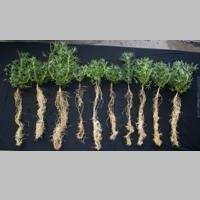Crop root study to boost Australian grain production

Researchers at The University of Western Australia say that "next frontier" of agricultural science is understanding the root system and function of crop plants to significantly increase Australian grain production, keep farms viable and help continue to feed the world despite the onset of increasing drought and climate change.
In a project at The University of Western Australia, researchers experimented with lupin roots with an overall aim to improve the water use and nutrient uptake of narrow-leaf lupin varieties that account for half of all grain legumes produced in Australia - an industry worth more than $600 million a year.
The study, published this week in the international journal Plant Soil, warned that Australian grain producers faced increasing threats from poor local soils, harsh growing conditions and declining, less-predictable rainfall due to climate change.
To help address this, a team led by UWA-based Chief Investigators Winthrop Professor Zed Rengel and Winthrop Professor Kadambot Siddique used new screening techniques and advanced computer modelling to understand lupin root systems variability.
"We screened world's largest lupin genetic resource collection and identified tremendous genetic variation in lupin root systems," Professor Zed Rengel said.
"Our findings may be used in breeding new varieties of lupins with modified root system and function that may produce higher yields in soils with relatively limited water and nutrient resources."
Similar approaches could also be used to identify genetic variation in root system and function in Australian cereal crops such as wheat and barley, said Winthrop Professor Kadambot Siddique, Director of the Institute of Agriculture at The University of Western Australia.
Professor Siddique said climate change and increased risk of drought made it imperative for Australia to develop new ways to make crops more water and nutrient-efficient.
Roots efficient in acquiring soil resources (water and nutrients) are fundamental to growing high-yielding crops in Australian soils, but have been largely ignored by scientists - "it's the next frontier of agricultural science", he said.
"Traditional crop root systems are poorly suited to the harsh environmental conditions of Australian agriculture. Their inefficient use of water and fertilisers not only reduces yields but also increases salinity and algal blooms (eutrophication) in waterways due to excessive nutrient run-off.
"Farming terms of trade - commodity value relative to production cost - have declined consistently over time. Although this has been offset substantially by increased production efficiency, the onset of climate change may ultimately make farming unprofitable and threaten our ability to feed the world."
"Use of nitrogen and phosphorus fertilisers to grow crops in water-limited, nutrient-poor Australian soils is a big cost that will increase for grain producers as energy prices rise and rock phosphate stocks dwindle.
"Improved and more efficient root capture systems may cut costs and substantially increase Australian grain harvest yields, with the added benefit that better nitrogen uptake may also significantly improve grain quality.
The UWA-based study - in collaboration with the Western Australian Department of Agriculture and Food, Tasmanian Institute of Agricultural Research and US Pennsylvania State University - was funded by an Australian Research Council Discovery Project grant and paves the way for further similar research in wheat and barley.
More information: Chen, Y.L., Dunbabin, V.M., Diggle, A.J., Siddique, K.H.M. and Rengel, Z. (2012). Assessing variability in root traits of wild Lupinus angustifolius gremplasm: basis for modelling root system structure. Plant and Soil 354: 141-155.
Chen, Y.L., Dunbabin, V.M., Postma, J., Diggle, A.J., Palta, J.A., Lynch, J.P., Siddique, K.H.M. and Rengel, Z. (2011). Phenotypic variability and modelling of root structure of wild Lupinus angustifolius genotypes. Plant and Soil 348: 345-364.
Chen, Y.L., Dunbabin, V.M., Diggle, A.J., Siddique, K.H.M. and Rengel, Z. (2011). Development of a novel semi-hydroponic phenotyping system for studying root architecture. Functional Plant Biology 38: 355-363.
Provided by University of Western Australia
















